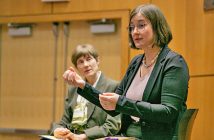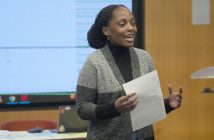Catholic leaders should plan to meet the changing pastoral needs of their Hispanic parishioners as they continue to make up an ever-greater percentage of the American church.

Father Allan Figueroa Deck, S.J. Photos by Gina Vergel
That was the theme of the Metropolitan Convocation of the Pastoral de Conjunto Hispana, a tri-state conference and workshop hosted on Oct. 3 by Fordham University at its Rose Hill campus in the Bronx.
Nearly 200 leaders from Hispanic churches and parishes from New York, New Jersey and Connecticut converged on the McGinley Center for the all-day conference.
The National Conference of Catholic Bishops approved the Pastoral de Conjunto, or National Pastoral Plan for Hispanic Ministry, in 1987. The plan, which provides for pastoral priorities and action for Hispanic ministry at the diocesan, regional and parish levels, is addressed to the entire church in the United States.
“Here you will discuss pastoral strategies for the future of the church,” said Joseph M. McShane, S.J., president of Fordham, in welcoming attendees. “But you are not looking at the past. Rather, you embrace the future.”
Hispanic Catholics make up about 39 percent—or 25 million—of the nation’s 65 million Catholics. Since 1960, Hispanics have accounted for 71 percent of the Catholic growth in the United States.
How pastoral agents—bishops, priests, religious and laypeople—plan for the future of Hispanic Catholic Ministry in the U.S. was the central topic as attendees participated in small group discussions and exercises.
“This is an opportunity for Hispanic leadership to get together, collaborate and live the pastoral conjunto,” said Rudy Vargas IV, the executive director of the Northeast Hispanic Catholic Center in Manhattan and president of the event’s coordinating committee. “We know that our people are projected to be 50 percent of the population in the United States by 2020. Our population is growing, but our ministry is not prepared.”
Parishioners need inspiration by way of actions from the Hispanic leadership, Vargas added.
Allan Figueroa Deck, S.J., the executive director of the Secretariat of Culture Diversity in the Church of the United States Conference of Catholic Bishops, has witnessed the growth of Hispanic Catholics in his four decades of working with the population.
“The population continues to grow, not because of immigration, but rather that children of Hispanics are born here,” he said. “That’s a very important detail because it means we must shift our focus in many ways. English is the main language for these children and grandchildren of immigrants. We must have a plan that takes this into consideration.”
Father Figueroa Deck also noted that it is the first time in the history of the Catholic Church in the United States that there is so much diversity among its parishioners, especially among Hispanics.

Father Joseph M. McShane, S.J., president of Fordham
“Though 65 percent of the Hispanics in the U.S. have their roots in Mexico, the population is growing in diversity every day,” he said. “We must make adjustments for this diverse population and also work with our parishioners so that everyone feels welcomed.”
A nine-person committee coordinated the event, including Claudio M. Burgaleta, S.J., professor of theology in Fordham’s Graduate School of Religion and Religious Education.
A symposium planned for next October also will be hosted at Fordham University.
“Fordham University and, in particular, Father McShane, have always supported Hispanics. He has always ensured that the Hispanic community feels at home here at the University,” Father Burgaleta said. “They have given many scholarships to students in the Latin Ministry programs at the Graduate School of Religion and Religious Education, and we are very grateful for that.”


